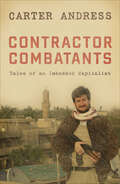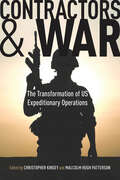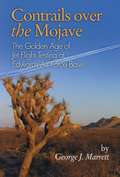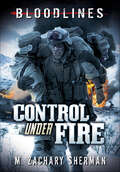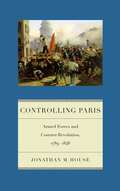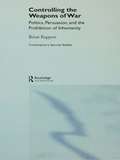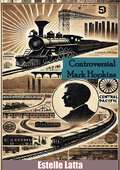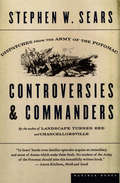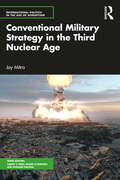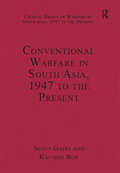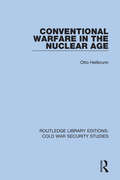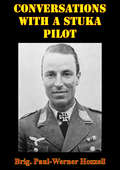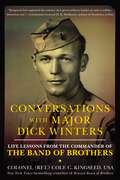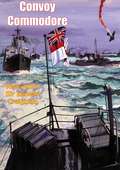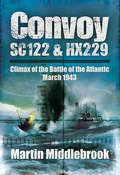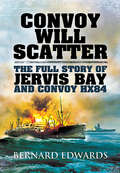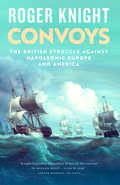- Table View
- List View
Contractor Combatants: Tales of an Imbedded Capitalist
by Carter AndressAn insider account an entrepreneur hired to support American peacekeeping efforts in Iraq in the wake of the fall of Saddam Hussein’s regime.The enemy is everywhere in war-torn Iraq, and suppliers and construction workers run the same risks as uniformed combatants: guerrilla attacks, suicide bombings, rocket bombardments, and road mines. This is the compelling story of Carter Andress and the unique methods his multinational team used to deliver vital supplies to coalition forces and help rebuild the devastated country. Armed to the teeth with AK-47s, sidearms, and bags full of grenades, these “contractor combatants” engaged in deadly firefights with the enemy while attempting to fulfill their mission and defend their own lives. Some gunned down insurgents. Others were themselves killed. This riveting war story is the first to define the role of this new breed of private warrior and to do so in a gripping and highly graphic narrative.
Contractors and War: The Transformation of US Expeditionary Operations
by Christopher Kinsey Malcolm Hugh PattersonThe U. S. military is no longer based on a Cold War self-sufficient model. Today's armed forces are a third smaller than they were during the Cold War, and yet are expected to do as much if not more than they did during those years. As a result, a transformation is occurring in the way the U. S. government expects the military to conduct operations-with much of that transformation contingent on the use of contractors to deliver support to the armed forces during military campaigns and afterwards. Contractors and Warexplains the reasons behind this transformation and evaluates how the private sector will shape and be shaped by future operations. The authors are drawn from a range of policy, legislative, military, legal, and academic backgrounds. They lay out the philosophical arguments supporting the use of contractors in combat and stabilization operations and present a spectrum of arguments that support and criticize emergent private sector roles. The book provides fresh policy guidance to those who will research, direct, and carry out future deployments.
Contrails Over the Mojave
by George J. MarrettIn Contrails over the Mojave George Marrett takes off where Tom Wolfe's The Right Stuff ended in 1963. Marrett started the Air Force Test Pilot School at Edwards AFB only two weeks after the school's commander, Col. Chuck Yeager, ejected from a Lockheed NF-104 trying to set a world altitude record. He describes life as a space cadet experiencing 15 Gs in a human centrifuge, zero-G maneuvers in a KC-135 "Vomit Comet," and a flight to 80,000 feet in the F-104A Starfighter. After graduating from Yeager's "Charm School," he was assigned to the Fighter Branch of Flight Test Operations, where he flew the latest fighter aircraft and chased other test aircraft as they set world speed and altitude records.Marrett takes readers into the cockpit as he "goes vertical" in a T-38 Talon, completes high-G maneuvers in an F-4C Phantom, and conducts wet-runway landing tests in the accident-prone F-111A Aardvark. He writes about Col. "Silver Fox" Stephens setting a world speed record in the YF-12 Blackbird and Bob Gilliland testing speed stalls in the SR-71 spy plane, but he also relives stories of crashes that killed test pilot friends. He recounts dead-sticking a T-38 to a landing on Rogers Dry Lake after a twin-engine failure and conducting dangerous tail hook barrier testing in a fighter jet without a canopy. A mysterious UFO sighting in the night sky above the Mojave Desert, known as "The Edwards Encounter," also receives Marrett's attention. Whether the author is assessing a new aircraft's performance or describing the experiences of test pilots as they routinely faced the possibility of death, this look at the golden age of flight testing both thrills and informs.
Control Under Fire (Bloodlines)
by M. Zachary ShermanTechnology and air superiority equals success in modern warfare. But even during the War in Afghanistan, satellite recon and smart bombs cannot replace soldiers on the ground. When a SEAL team SeaHawk helicopter goes down in the icy mountains of Kandahar, Lieutenant Lester Donovan must make a difficult decision: follow orders or go "off mission" and save his fellow soldiers. With Taliban terrorists at every turn, neither decision will be easy. He'll need his instincts and some high-tech weaponry to get off of the hillside and back to base alive!
Controlling Intelligence (Studies in Intelligence)
by Glenn P. HastedtThe vital ingredient in the formulation and execution of a successful foreign policy is intelligence. For the USA, as the Bay of Pigs incident and the Iran-Contra affair have shown, controlling intelligence is a problem which policy-makers and concerned citizens have rarely examined and imperfectly understood. Of the seven contributors, five have direct experience of working with or in intelligence, and all have written extensively on the subject.
Controlling Paris: Armed Forces and Counter-Revolution, 1789-1848 (Warfare and Culture #2)
by Jonathan M. HouseWhen not at war, armies are often used to control civil disorders, especially in eras of rapid social change and unrest. But in nineteenth century Europe, without the technological advances of modern armies and police forces, an army’s only advantages were discipline and organization—and in the face of popular opposition to the regime in power, both could rapidly deteriorate. Such was the case in France after the Napoleonic Wars, where a cumulative recent history of failure weakened an already fragile army’s ability to keep the peace.After the February 1848 overthrow of the last king of France, the new republican government proved remarkably resilient, retaining power while pursuing moderate social policies despite the concerted efforts of a variety of radical and socialist groups. These efforts took numerous forms, ranging from demonstrations to attempted coups to full-scale urban combat, and culminated in the crisis of the June Days. At stake was the future of French government and the social and economic policy of France at large.In Controlling Paris, Jonathan M. House offers us a study of revolution from the viewpoint of the government rather than the revolutionary. It is not focused on military tactics so much as on the broader issues involved in controlling civil disorders: relations between the government and its military leaders, causes and social issues of public disorder, political loyalty of troops in crisis, and excessive use of force to control civil disorders. Yet somehow, despite all these disadvantages, the French police and armed forces prevented regime change far more often than they failed to do so.
Controlling the Weapons of War: Politics, Persuasion, and the Prohibition of Inhumanity (Contemporary Security Studies)
by Brian RappertA fresh examination of the ethical and intellectual issues and dilemmas associated with attempts to establish formal humanitarian limits on weaponry. This new study considers how governments, non-governmental organizations, academics, political commentators and others have responded to the predicaments associated with imposing classifications about the relative acceptability of force and what is accomplished in their strategies for doing so. It develops these issues through combining thematic and conceptual analysis with the examination of varied cases of prohibitions on ‘conventional’ and ‘unconventional’ weapons through customary and statutory laws, multilateral treaties, UN resolutions, and national legislation. The book will appeal to students of security studies, military technology, peace studies, international relations and discourse theory.
Controversial Mark Hopkins
by Estelle Latta Mary L. AllisonIn Controversial Mark Hopkins, Estelle Latta examines the life and legacy of Mark Hopkins, one of the influential figures behind the Central Pacific Railroad and the development of America’s transcontinental rail system. Through detailed research and compelling narrative, Latta unpacks the complex story of a man who played a pivotal role in shaping the nation’s transportation infrastructure while courting both admiration and controversy.The book explores Hopkins’ rise from humble beginnings to his position as a member of the "Big Four" railroad magnates alongside Leland Stanford, Collis Huntington, and Charles Crocker. Latta delves into his business acumen, his reputation for honesty and frugality, and his crucial role in financing and managing the ambitious project that connected the East and West Coasts. However, the narrative also addresses the criticisms surrounding Hopkins and his associates, including allegations of monopolistic practices, labor exploitation, and the displacement of communities in the name of progress.Latta presents a balanced portrait of Hopkins as both a visionary and a contentious figure, set against the broader backdrop of 19th-century industrialization and America’s westward expansion. By weaving together personal anecdotes, historical analysis, and a keen exploration of the ethical dilemmas faced by Hopkins and his peers, Controversial Mark Hopkins offers a nuanced look at a man whose impact on American history remains significant and debated.This book is an essential read for those interested in the history of the transcontinental railroad, the Gilded Age, and the complexities of progress in a rapidly changing nation.
Controversies & Commanders: Dispatches from the Army of the Potomac
by Stephen W. SearsAn in-depth look at the Union force that went up against Robert E. Lee, from &“a master storyteller and leading Civil War historian&” (Kirkus Reviews). From an award-winning military historian and the bestselling author of Gettysburg, this is a wide-ranging collection of essays about the Army of the Potomac, delving into such topics as Professor Lowe&’s reconnaissance balloons; the court-martial of Fitz John Porter; the Lost Order at Antietam; press coverage of the war; the looting of Fredericksburg; the Mud March; the roles of volunteers, conscripts, bounty jumpers, and foreign soldiers; the notorious Gen. Dan Sickles, who shot his wife&’s lover outside the White House; and two generals who were much maligned: McClellan (justifiably) and Hooker (not so justifiably). This lively book follows the Army of the Potomac throughout the war, from 1861 to 1865, painting a remarkable portrait of the key incidents and personalities that influenced the course of our nation&’s greatest cataclysm.
Convencendo Jenna: Romance Contemporâneo
by Aspen DrakeLivro 2 na série Protegendo, mas pode ser lido fora de sequência. Ela sabe melhor do que confiar nele. Só porque ele tem um rosto bonito e a salvou no passado, isso não significa que ele é o homem para ela. Na verdade, todo instinto em seu intestino está dizendo a ela para fugir e se proteger de mágoa. Mas então ele sussurra em seu ouvido ou curva um dedo em sua direção e ela esquece porque ela ergueu uma parede entre eles. Ele pode ser perfeito para ela no papel, mas se Alex quer convencer Jenna de que ele nunca vai machucá-la, ele tem uma coisa convincente para fazer.
Convenience Voting and Technology
by Claire M. SmithOne of modern democracy's biggest challenges is the overseas voter. This book is the first of its kind to explore the issues of military and overseas voting, an often neglected voting bloc, by investigating the successfulness of overseas voting initiatives, technologies, and policy efforts.
Conventional Deterrence (Cornell Studies in Security Affairs)
by John MearsheimerConventional Deterrence is a book about the origins of war. Why do nations faced with the prospect of large-scale conventional war opt for or against an offensive strategy? John J. Mearsheimer examines a number of crises that led to major conventional wars to explain why deterrence failed. He focuses first on Allied and German decision making in the years 1939–1940, analyzing why the Allies did not strike first against Germany after declaring war and, conversely, why the Germans did attack the West. Turning to the Middle East, he examines the differences in Israeli and Egyptian strategic doctrines prior to the start of the major conventional conflicts in that region. Mearsheimer then critically assays the relative strengths and weaknesses of NATO and the Warsaw Pact to determine the prospects for conventional deterrence in any future crisis. He is also concerned with examining such relatively technical issues as the impact of precision-guided munitions (PGM) on conventional deterrence and the debate over maneuver versus attrition warfare.Mearsheimer pays considerable attention to questions of military strategy and tactics. Challenging the claim that conventional detrrence is largely a function of the numerical balance of forces, he also takes issue with the school of thought that ascribes deterrence failures to the dominance of "offensive" weaponry. In addition to examining the military consideration underlying deterrence, he also analyzes the interaction between those military factors and the broader political considerations that move a nation to war.
Conventional Military Strategy in the Third Nuclear Age (International Politics in the Age of Disruption)
by Joy MitraThis volume delves into the way conventional deterrence operates between nuclear-armed states in the third nuclear age. Unlike the first and second ages the advent of this new age has witnessed greater strain on the principles of mutual vulnerability and survivability that may result in increased risks of advertent or inadvertent escalation and horizontal nuclear proliferation. The book looks at the sum of three key simultaneous developments in the third nuclear age that merit attention. These include the emergence of asymmetric strategies, the introduction of unmanned platforms and the expansion of nuclear arsenals. The volume discusses how these concurrent developments might shape the practice of conventional deterrence and provides useful insights into conventional military dynamics, not just among the current nuclear dyads but also ones that may emerge in future. It seeks answers to several key issues in state security not limited to — • What purpose and scope does the conventional military instrument have in a state’s overall military strategy versus other nuclear-armed states? • If mutual vulnerability and deterrence are the frameworks, why did the prospect of escalation appear in the first place? • What are the trends — political, doctrinal, or technological — that augment or diminish conventional and nuclear interface? With insights on military crises that have witnessed participation from nuclear-armed states like the United States, Russia, China, Pakistan, and India this book will especially be of interest to scholars and researchers working in the areas of security and deterrence studies, defence and strategic studies, peace and conflict studies, and foreign policy. It will also appeal to policymakers, career bureaucrats, security and defense practitioners, and professionals working with think tanks and embassies.
Conventional Warfare in South Asia, 1947 to the Present (Critical Essays on Warfare in South Asia, 1947 to the Present)
by Kaushik RoyThe essays included in this volume focus on conventional war on land, sea and air fought by the states of South Asia and their impact on the host societies and economies. The authors are drawn from academia and the military in India and Pakistan, as well as from outside the subcontinent in order to give a wide perspective. In the introduction the editors describe the changing contours of warfare in South Asia, and the similarities and dissimilarities with warfare in the Middle East and South East Asia. The volume highlights the influence of extra-regional powers like China, Russia and the US in providing arms, munitions and shaping the texture of military doctrines and force structures of the South Asian powers.
Conventional Warfare in the Nuclear Age (Routledge Library Editions: Cold War Security Studies #17)
by Otto HeilbrunnThis book, first published in 1965, examines the doctrine for fighting a conventional war against a nuclear power. Troops must be deployed as if they were fighting a nuclear war: dispersed over a greatly extended battlefield, conducting mobile operations, with no fixed front line, or static defence system, or defence zone. A new strategy of forward defence is needed, whereby significant numbers of troops are dispatched into the enemy’s rear, and this book lays out such a strategy, and thereby sets a proposal for the future safety of Western Europe.
Conversations On Common Things: With Questions (classic Reprint)
by Dorothea Lynde DixConversations On Common Things: Or Guide to Knowledge by Dorothea Lynde Dix is a delightful and enlightening compendium that aims to educate and inspire young minds through engaging and accessible dialogues. First published in the early 19th century, this timeless classic serves as both a practical guide and a stimulating read, making the acquisition of knowledge a joyful experience.Dorothea Lynde Dix, renowned for her advocacy for the mentally ill and her pioneering work in social reform, brings her passion for education to the forefront in this book. Structured as a series of conversations between a knowledgeable adult and inquisitive young learners, the book covers a wide array of subjects, including geography, history, science, and everyday practical knowledge.Each conversation is thoughtfully crafted to spark curiosity and encourage critical thinking, presenting complex ideas in a manner that is both comprehensible and engaging for young readers. From understanding the natural world to exploring the wonders of human achievement, "Conversations On Common Things" offers a holistic approach to education that transcends the limitations of traditional rote learning.Dix's pedagogical approach emphasizes the importance of nurturing a child's natural curiosity and fostering a love for learning. Her dialogues are imbued with warmth and patience, making the learning process enjoyable and relatable. This book not only provides factual knowledge but also instills values of intellectual inquiry, moral integrity, and the importance of continuous learning.Conversations On Common Things stands as a testament to Dorothea Lynde Dix’s dedication to education and her belief in the transformative power of knowledge. It is an essential read for parents, educators, and young learners alike, offering insights that remain relevant and valuable even today. Whether used as a homeschooling resource or a supplemental educational tool, this book continues to inspire and educate generations of readers, fostering a lifelong love of learning and curiosity about the world.
Conversations With A Stuka Pilot [Illustrated Edition]
by Brigadier-General Paul-Werner HozzellIncludes the World War Two On The Eastern Front (1941-1945) Illustration Pack - 198 photos/illustrations and 46 maps.General Hozzel is one of a few remaining German officers who fought in the Second World War and held position high enough to allow generalizations about the war and to extract historical genre for future operations.Due to special circumstances involving the eleventh hour sickness of his commanding officer, Hozzel, as a lieutenant, led a group of Stuka (JU-87) aircraft from East Prussia into combat against the Poles in 1939 in the first Blitzkrieg in modern war...Hozzel led his Stukas against the heavy Polish fortification on the Narwa River line and is credited with breaking them with the most accurate tactical bombing technique of the Second World War-the classic high angle Stuka attack...Late in 1941, Hozzel moved to the Eastern Front where he had the distinction as a major, later in 1942, to command the famed Immelmann Wing. The Wing was reinforced to compose over 200 aircraft in support of the 6th Army and its advance toward Stalingrad in Aug. 1942...Later in the year, he initiated the dive bombing operations against the heavy Soviet fortifications in Stalingrad through the dense air defense network screening the city. At the end of 1942, Hozzel conducted defensive air operations against the great Soviet offensive which drove the Germans back to the Central Ukraine. His last, operation as a commander of Stuka units was during Operation Citadel in support of the southern prong of the German attack near Kursk...In late 1944, moved to the Northern Front where he ended the war as Chief of Staff of the Luftwaffe Air Fleet supporting the German army group backed up against the sea in the Kurland (Latvian) pocket. These final experiences in combat against the Soviets are particularly instructive.
Conversations with Major Dick Winters
by Cole C. KingseedOn the hellish battlefields of World War II Europe, Major Dick Winters led his Easy Company--the now-legendary Band of Brothers--from the confusion and chaos of the D-Day invasion to the final capture of Hitler's Eagle's Nest. But Winters's story didn't end there. It was only the beginning. He was a quiet, reluctant hero whose modesty and strength drew the admiration of not only his men, but millions worldwide. Now comes the story of Dick Winters in his last years as witnessed and experienced by his good friend, Cole C. Kingseed. Kingseed shares the formative experiences that made Winters such an effective leader. He addresses Winters's experiences and leadership during the war, his intense, unbreakable devotion to his men, his search for peace both without and within after the war, and how fame forced him to make adjustments to an international audience of well-wishers and admirers, even as he attempted to leave a lasting legacy before joining his fallen comrades. Following Winters's death on January 2, 2011, the outpouring of grief and adulation for one of this nation's preeminent leaders of character, courage, and competence shows just how much of an impact Dick Winters left on the world. This is a story of leadership, fame, and friendship, and the journey of one man's struggle to find the peace that he promised himself if he survived World War II.
Convertidos: La Batalla de Nueva York
by Laura Rebollo RajNO SE EQUIVOQUE - Este libro no trata de zombis con muchas escenas gore de asesinatos a base de morder carne humana. ESTE LIBRO TRATA DE UNA GUERRA. Una guerra a causa de una repentina epidemia provocada por un virus. Pero no es tan sencillo. Hay preguntas que necesitan explicación. ¿Cómo se supo acerca del virus? ¿Cómo convirtió a los humanos en zombis, haciéndolos máquinas caníbales descerebradas y, a la vez, lo suficientemente inteligentes como para trabajar juntos y llevar a cabo estrategias de batalla contra los ejércitos humanos? ¿Hubo alguien detrás del brote? ¿Algún estado al margen de la ley, una organización terrorista o...? Año 2035 La gente empeza a desaparecer de forma misteriosa en las principales ciudades del mundo sin dejar rastro. Días más tarde, empiezan a aparecer del mismo modo misterioso, pero ya no son los mismos de antes. Se han CONVERTIDO en monstruos caníbales, enloquecizos, con habilidades físicas mejoradas pero capacidad mental reducida y... aún así, trabajan juntos en grupo, matan lo bastante como para saciar su hambre y CONVIERTEN al resto para aumentar sus fuerzas. Las fuerzas de la policía y los ejércitos utilizan francotiradores para reventarles la cabeza por completo, pero resulta que el virus no se transmite simplemente por sus mordidas; existe otra forma pero, cuando descubren cómo, ya es demasiado tarde. Año 2036 - seis meses más tarde Aumentan en número a más de medio millón y todos los países deciden lanzar ataques a gran escala contra los ejércitos de convertidos que han tomado las ciudades principales y los principales centros de población. Con múltiples batallas grandes y no tan grandes, se convierte en una guerra mundial; una guerra que une al mundo entero por primera vez en la historia. La guerra tiene lugar entre los años 2036 y 2040. Hay feroces batallas como la
Convincendo Jenna
by Aspen DrakeConvincendo Jenna Per Jenna è molto difficile fidarsi, anche dopo che Alex le ha dimostrato di essere una persona affidabile. Jenna esita a fidarsi di lui. Solo perché ha un bel faccino e l’ha salvata in passato, non significa che Alex sia l’uomo giusto per lei. Anzi, l’istinto le dice di scappare da lui per non ritrovarsi con il cuore spezzato. Ogni volta che Alex si intromette nella sua vita, Jenna si chiede perché abbia agito in modo da erigere un muro tra loro. Alex potrebbe essere l’uomo perfetto per lei a parole, ma se davvero vuole convincere Jenna del fatto che non ferirà i suoi sentimenti, avrà filo da torcere. Convincendo Jenna Per Jenna è molto difficile fidarsi, anche dopo che Alex le ha dimostrato di essere una persona affidabile. Jenna esita a fidarsi di lui. Solo perché ha un bel faccino e l’ha salvata in passato, non significa che Alex sia l’uomo giusto per lei. Anzi, l’istinto le dice di scappare da lui per non ritrovarsi con il cuore spezzato. Ogni volta che Alex si intromette nella sua vita, Jenna si chiede perché abbia agito in modo da erigere un muro tra loro. Alex potrebbe essere l’uomo perfetto per lei a parole, ma se davvero vuole convincere Jenna del fatto che non ferirà i suoi sentimenti, avrà filo da torcere.
Convoy Ambush Case Studies
by Richard E. KillblaneWhen the enemy adopts a policy to attack convoys, truck drivers become front line troops. Convoy commanders must then become tacticians. How to study war? The student of tactics studies previous fights and mentally places himself in the position of the participants. Knowing what they knew, how would he have reacted? In hind sight, what was the best course of action, remembering that there is no one perfect solution? Any number of actions would have succeeded. The tactician must learn what would have worked best for him. For this reason, I have pulled together all the examples of convoy ambushes. The 20th century, Vietnam War, and current war in Iraq provide a wealth of examples of convoy ambushes from which to study. Unfortunately, the US Army did not record many good accounts of ambushes during the Vietnam War. Much of what is presented in this text is based upon oral interviews of the participants, sometimes backed by official record, citations or reports. For this reason, some of the ambush case studies present only the perspective of a crew member of a gun truck or the convoy commander. Since this academic study works best when one mentally takes the place of one of the participants, this view of the ambush serves a useful purpose. After my own review of the ambushes, I have drawn my own conclusion as to what principles apply to convoy ambushes.
Convoy Commodore
by Rear-Adm. Sir Kenelm CreightonOn September 4, 1939, Admiral Creighton, who had retired from the Navy five years earlier, reported again to the Admiralty for service as a Commodore of Ocean Convoys. In the following three years he conducted 24 convoys to various parts of the world.The greater part of this time was spent on the North Atlantic route with its violent storms and the continual menace of U-boat attack. But there were other destinations, such as Suez via the Cape of Good Hope, and Casablanca—where the convoy sailed to repatriate 15,000 French troops after the fall of France, and found itself under arrest. In 1941 Admiral Creighton narrowly escaped with his life when the ship he was in was sunk by a U-boat near Gibraltar. Another ship in which he was travelling as a passenger, accompanied by his wife, was torpedoed and sunk by German aircraft.Besides a wealth of personal experiences Admiral Creighton gives us a broader picture of the work done by convoys throughout the last war. From his senior position, and with an intimate knowledge of the subject, he is able to convey graphically the true nature of this dangerous and vital task.“Rear-Admiral Creighton served for the three opening years of World War II as Commodore of ocean convoys, mainly in the dour North Atlantic. He was twice sunk, once near Gibraltar, the second time when going to take up a final appointment in Egypt. His narrative is enthralling....The life of an ocean commodore in war has rarely been described in detail; its responsibilities have never been better conveyed.”—British Book News“Twenty-five convoys...some fast, most of them slow, some to hot climates, but mostly that gruelling trip across the Atlantic to Halifax, Nova Scotia, in the face of westerly gales, snow and ice which were often worse enemies than the U-boats.”—Evening News
Convoy SC122 and HX229: Climax of the Battle of the Atlantic, March 1943
by Martin Middlebrook"Winston Churchill wrote, The only thing that ever really frightened me during the war was the U-boat peril. Had the convoy link between North America and Britain been broken, the course of World War II would have been different. As it was, there was a period during the winter of 1942-43 when the Germans came close to cutting the North Atlantic lifeline. In the first twenty days of March, 1943, the Germans sank ninety-seven Allied merchant ships twice the rate of replacement. During the same period seven U-boats were lost and fourteen put in service. No wonder Churchill was worried.Convoys SC122 and HX229 sailed from New York harbor for England early in March 1943. Admiral Doenitz deployed forty-two U-boats to trap those two convoys. Twenty-one merchant ships were sunk in the ensuing battle. The Germans called it the greatest convoy battle of all time. It was a major turning point in the Battle of the Atlantic.In Convoy, every maneuver of the merchant ships, their escort vessels, the long range aircraft cover, and the attacking U-boats is documented in a powerful narrative that will recall for many readers Nicholas Monsarrats best-selling novel The Cruel Sea. In many ways, this book could be the story of any of the hundreds of convoys that sailed the ocean during the war. One important chapter throws new light on three controversial aspects of the Battle of the Atlantic: why there was an Air Gap long after full air cover could have been provided, why the convoys had to sail with dangerously weak naval escorts; and how the Allies outwitted the Germans in the radio decoding war."
Convoy Will Scatter: The Full Story of Jervis Bay and Convoy HX84
by Bernard EdwardsA naval historian reveals the full story of the HMS Jervis Bay and the merchant ships that valiantly saved lives during the WWII Battle of the Atlantic. On November 5th, 1940, the thirty-eight merchant ships of Convoy HX84 were making their way across the North Atlantic, escorted by the armed cruiser HMS Jervis Bay. In mid-ocean, they were attacked by the German pocket battleship Admiral Scheer. Though the Jervis Bay charged at the enemy, she was hopelessly outgunned. Within twenty-two minutes, the ship was destroyed. Meanwhile, the merchantmen scattered under the cover of a smokescreen. But the radar-equipped Admiral Scheer was still capable of picking them off one at a time. Captain Hugh Pettigrew, commanding the highly armed Canadian Pacific cargo liner SS Beaverford, began a desperate game of hide and seek with the Scheer, which continued until the Beaverford was sunk with no survivors. Thanks to this sacrifice, thirty-three merchantmen were able to escape. Later the neutral flag Swedish freighter Stureholm, commanded by Captain Olander, picked up survivors from the Jervis Bay. While Jervis Bay&’s Captain Edward Fegen was rightly awarded the Victoria Cross for his bravery and sacrifice, the history books only mention the Beaverford and the Stureholm in passing. This thrilling book puts the record straight.
Convoys: The British Struggle Against Napoleonic Europe and America
by Roger KnightThe first account of Britain’s convoys during the Napoleonic Wars—showing how the protection of trade played a decisive role in victory During the Napoleonic Wars thousands of merchant ships crisscrossed narrow seas and wide oceans, protected by Britain’s warships. These were wars of attrition and raw materials had to reach their shores continuously: timber and hemp from the Baltic, sulfur from Sicily, and saltpeter from Bengal. Britain’s fate rested on the strength of its economy—and convoys played a vital role in securing victory. Leading naval historian Roger Knight examines how convoys ensured the protection of trade and transport of troops, allowing Britain to take the upper hand. Detailing the many hardships these ships faced, from the shortage of seaman to the vicissitudes of the weather, Knight sheds light on the innovation and seamanship skills that made convoys such an invaluable tool in Britain’s arsenal. The convoy system laid the foundation for Britain’s narrow victory over Napoleon and his allies in 1815 and, in doing so, established its naval and mercantile power at sea for a hundred years.
